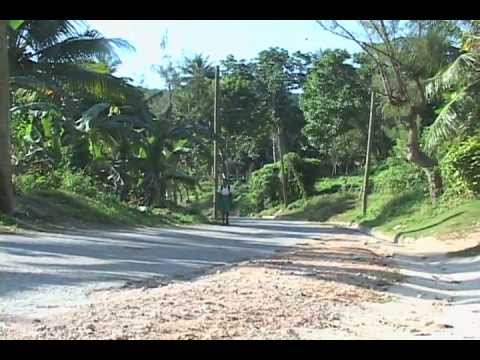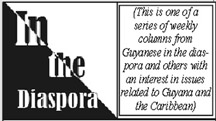Esther Figueroa, Ph.D. is an activist independent film maker, writer, linguist and educator who focuses on the environment, social justice, indigenous knowledges and local content. “Limbo” , her 2014 novel about Jamaica is an environmental murder mystery. Her most recent feature documentary “Fly Me To The Moon” (to be released later this year) is about aluminum, modernity, the political economy of our material culture and consumption, and is a call for us to stop destroying the natural world that we all depend upon.
Fifty years ago July 20 1969, Apollo 11 landed on the moon, and Neil Armstrong became the first human to walk on the surface of that beautiful celestial orb that we watch wax and wane from our home Planet Earth. To get to the moon was a remarkable feat that required tens of thousands of people working across many different disciplines. It required immense sacrifice, not only of the lives that were lost in previous space flights, and of those who dedicated countless hours of their lives to solving the challenges of completing the mission, but also the sacrifice of people and places not often thought of when one thinks about the United States of America’s shining moment of greatness. The Apollo 11 capsule was constructed primarily of aluminum, and aluminum is made from bauxite, the rich red soil strip mined and shipped out of South America and the Caribbean for over one hundred years, first from British and Dutch Guiana (now Guyana and Suriname) and later Haiti and Jamaica. Completely surrounded by the Caribbean Sea, a small island 4,240 square miles in size, Jamaica was the world’s largest producer of bauxite when Apollo 11 landed on the moon.
Aluminum, Planet Earth’s most abundant metal, is the most widely used non-ferrous metal. It is lightweight, durable, malleable, non corrosive and chemically reactive. Aluminum is the material that made 20th century modernity possible, and being essential to warfare is considered a strategic metal stock piled by governments who fear its scarcity. The electricity grid, the buildings we live and work in, the satellites and gadgets we use to communicate, the way people and goods move from place to place, the power, speed, mobility and conveniences that we take for granted, from the most common soda cans and chewing gum wrappers, to hydro-electric dams, fast food franchises, skyscrapers, automobiles, airplanes, smart phones and nano technology, are all made possible by aluminum, the material that underpins our material culture and our ideas of what it means to be modern.
During World War II, when all countries involved in war were ramping up their aluminum production needed for everything from planes to bombs, Britain, the colonial masters of Jamaica, researched the availability of bauxite in Jamaica and plans were drawn up to begin extraction. The urgency of the search for bauxite in Jamaica was because German U-boats were successfully targeting the transshipment of bauxite from the Guianas to North America for smelting into aluminum, sinking ships carrying the ore. Jamaica was the attractive alternative to the Guianas because Jamaica is geographically close to North America, with abundant bauxite close to the surface easy to extract. So the large multinational aluminum corporations Reynolds, Alcan, Kaiser, Alcoa, all set up operations in Jamaica in the beginning of the 1950s. In 1952, the first shipment of bauxite was exported from Jamaica and the first batch of alumina was processed in Jamaica. These corporations controlled about 10% of Jamaica’s land and at the time paid a mere shilling a ton – about 20 cents per ton – for extraction. It was the Korean War, declared in 1950, that made Jamaica central to bauxite production for North America, as again war required aluminum in very large quantities.
Jamaica has for 67 years exported bauxite and processed alumina. And new mining leases have been awarded for the next 30 years which would project Jamaica into at least a century of extraction. We have never smelted aluminum because it is the most energy intensive industry so requires cheap electricity (usually hydro electric, coal or liquid gas) and Jamaica has one of the most expensive electricity costs. The large vertically integrated aluminum multinationals left Jamaica long ago. Their discontent began in the 1970s when the Michael Manley government imposed a bauxite levy and other actions aimed at having greater local control over the industry and receiving more income for the extraction and processing of our “natural resources.” In time Alcan and Alcoa were replaced by the likes of Marc Rich and Glencore, commodity traders and vulture capitalists only interested in maximizing profit by raiding assets, then by Russian oligarchs, and most recently China State Owned industrial corporations new to the aluminum market.
What are the consequences of Jamaica’s participation in the aluminum industry? A government addicted to the foreign exchange it receives through its partnership and co-ownership deals and therefore committed to the industry at all costs. These costs include ecocide, deforestation, water, air and soil pollution, ill health of residents especially of persons living within a ten mile radius of extraction and processing, the destruction and displacement of intact, self sufficient rural communities and the loss of local agricultural production and the way of life associated with such communities. Jamaica imports over 80% of its food. You can’t keep destroying fertile land by strip mining it and removing the soil, and you can’t keep displacing and impoverishing those who grow the food and expect to have food security. The Government of Jamaica holds ownership rights to all minerals, therefore Jamaican property owners do not own what is in the soil on their property. Once a mining lease has been granted and a company wants to mine bauxite, they simply need to give the owner two weeks’ notice and they can come onto the property and mine. Bauxite mining is therefore a main factor behind the highly urbanized nature of Jamaica via the out migration of rural Jamaicans, either into towns and cities or away from Jamaica to “foreign.” The mass migration of Jamaicans to the UK in the 1950s and early 60s was partly fueled by the massive accumulation of land by the multinationals for bauxite mining.
Today, in Albert Town, Trelawny, the yam producing belt of Cockpit Country, South Trelawny Environmental Agency, long time advocates for the protection of Cockpit Country, are holding a day long event that will educate the public about the threats of extraction, and will protest bauxite mining across Jamaica, in particular mining in Cockpit Country. This stand against bauxite mining is part of renewed activism and community organizing in response to the aggressively expanding bauxite mining currently affecting communities in Western St. Ann. And because the government of Jamaica is about to grant Special Mining Lease 173 to Noranda Bauxite Jamaica Ltd. (also know as New Day), of which the government is majority owner, to mine a large portion of Cockpit Country. This lease is currently in the typically bogus Environmental Impact Assessment (EIA) process, whereby fraudulent scientists (usually professors and/or graduates of the University of the West Indies) declare that the environment was degraded to begin with, that any negative impacts will be easily mitigated, and that mining activities will be an economic bonanza for the communities which are to be mined. The EIA process however does require community consultation, so public meetings held about the mining plans alerted communities to the imminent threat of mining and the need to urgently organize against SML 173. And so the protests have begun.
Bauxite reserves can be found in more than 25% of Jamaica and extraction takes place in St. Catherine, St. Ann, Clarendon, Manchester, St. Elizabeth and now Trelawny. Cockpit Country is a large area of west central Jamaica that is very important to Jamaica. It is our largest remaining intact original forest with high levels of biological diversity and rare species. The trees attract high rain fall that percolates through limestone into large underground reservoirs that are the source of six of Jamaica’s major rivers and provide 40% of Western Jamaica’s water. Cockpit Country is also of great historical and cultural significance to Jamaica as a symbol of resistance, since it is the home of the Western Maroons who successfully fought the English for many years and were finally granted their own governance in 1738, long before Jamaica received political independence from Britain in 1962.
In 2007, in response to our activism against new mining leases being given out in Cockpit Country, the government of Jamaica announced that there would be no mining in Cockpit Country, but that the boundaries of Cockpit Country had to be first defined. What followed over about ten years was a high stakes political game of studies, public consultations and lots of meetings with technocrats and “stakeholders.” Eventually on 21 November 2017, Prime Minister Andrew Holness declared in parliament that approximately 74,726 hectares had been demarcated as the Cockpit Country Protected Area. It is important to note that this protected area is actually not legally protected yet because before it can become law the boundary has to be “truthed” which means walking the boundary and adjusting the proposed boundaries based on various factors. The CCPA is the smallest of all of the boundaries that were proposed by stakeholders, it protects almost all the mining interests by leaving the areas most wanted by the bauxite industry open to mining, while also allowing mining right up to the boundary with no buffer protective zone. Many important ecosystems, rivers, watersheds and communities have been left out of the protected area. The Albert Town day of protest that takes place today calls for the protection of all of Cockpit Country, not just the area declared protected by the Prime Minister, and calls for the end to bauxite mining and all other destructive extractive practices. In a time of climate crisis with record high temperatures, unpredictable weather with long droughts and catastrophic storms, we cannot be cutting down our trees and polluting and depleting our soil and water. Please act in solidarity with the people of Jamaica who are fighting to protect our island and to leave a livable world for generations to come.
To find out more about these issues visit face book pages: Protect Jamaica’s Cockpit Country, Jamaica Environment Trust, Cockpit Country Warriors. Visit web pages www.cockpitcountry.com, www.savecockpitcountry.org. Follow Jamaica Environment Trust on twitter and instragram. And you can watch my videos on Cockpit Country including
“Cockpit Country Voices From Jamaica’s Heart” (2007): http://youtu.be/x2Psj_UcqQY
“Cockpit Country Is Our Home” (2012): http://youtu.be/ylqTfu07PJA


